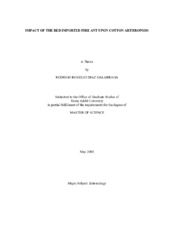| dc.description.abstract | Inclusion/exclusion field experiments demonstrated that the red imported fire ant, Solenopsis invicta Buren, did not affect the abundance of 49 groups of insects and spiders collected in pitfall traps. However, arthropod diversity was significantly greater (H' = 2.829) in exclusion plots relative to inclusion plots (H' = 2.763). Moreover, this study demonstrated that S. invicta can have an important impact upon cotton arthropod communities, including key predator species. Densities of ground beetles (Carabidae), spiders, lacewings (Chrysoperla spp.), and minute pirate bugs (Orius spp.) were significantly lower in the presence of S. invicta. However, populations of aphidophagous insects such as Hippodamia spp. and Scymnus spp. increased with cotton aphid (Aphis gossypii Glover) density early in the season. Abundance of cotton aphids was ca. 5x greater in inclusion plots, likely due to protection and tending by S. invicta. This increase was observed early in the season, though aphid populations did not reach economic levels. Predation of sentinel bollworm [Helicoverpa zea (Boddie)] and beet armyworm (Spodoptera exigua Hubner) eggs increased 20-30%, when S. invicta was present. Most predation of sentinel beet armyworm egg masses, measured via direct nocturnal observations, was due to S. invicta (68%) and cotton fleahopper [Pseudatomoscelis seriatus (Reuter)] (21%) in plots with S. invicta, and by the mite Abrolophus sp. (52%), spiders (13%) and minute pirate bug (13%) in plots without S. invicta. The frequencies of minute pirate bug, cotton fleahopper, S. invicta and native ants in beat bucket samples did not accurately reflect the frequency with which they were observed feeding on sentinel noctuid eggs. Overall, the results of these studies demonstrated that S. invicta was associated with declines in the abundances of minute pirate bug, spiders, and lacewing and with an increment in cotton aphid populations, though they did not reach the economic threshold. Moreover, S. invicta significantly increased predation of bollworm and beet armyworm eggs. All together, the results suggested that S. invicta has a net positive impact on cotton pest management. | en |


